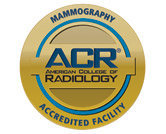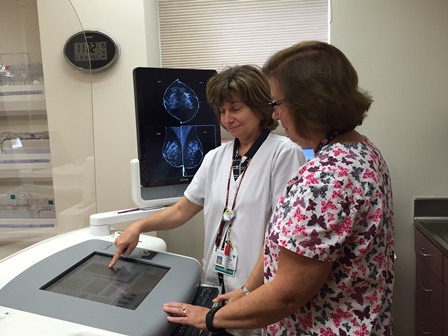Accurate, high-quality imaging is fundamental to proper diagnosis and breast care. That’s why The Center for Breast Health has its own imaging division, devoted entirely to our patients, in one convenient location.
Our imaging facility is staffed with technologists who have extensive clinical expertise and training in breast diagnostics and imaging. That makes a difference, because they understand the unique needs of women. It’s their sole specialty, day in and day out, and it shows.

That expertise and compassion are backed by the most innovative imaging technology available for both screening and diagnostic procedures, which include:
- Screening and diagnostic mammography – Performed by a certified technologist, and interpreted by a radiologist specializing in breast imaging.
- Focal breast sonography – Also known as ultrasound, this technology uses sound waves to further evaluate abnormalities.
- Fine needle aspiration – For this procedure, a radiologist uses a very thin needle to remove a small amount of fluid or tissue for analysis.
- Stereotactic breast biopsy – This is a minimally invasive procedure that uses local anesthesia. A radiologist uses mammographic X-rays to find the precise location of abnormal tissue. He or she then takes a small sample of the tissue for analysis.
- Core breast biopsy – A minimally invasive procedure done under local anesthesia, a radiologist uses ultrasound guidance to find and sample the suspicious area.
Three-Dimensional (3D) Mammography

Our imaging center offers the latest in breast cancer imaging detection technology, 3D mammography. 3D mammography, also known as tomosynthesis, is used in conjunction with 2D digital mammography. 3D mammography produces three dimensional images of the breast from multiple angles using a small rotating digital scanner. Radiologists and technicians can move and enlarge the images to view any area of concern.
- A 3D mammography procedure examines breast tissue layer by layer, enabling higher visibility and clarity than a flat view.
- It provides greater accuracy in pinpointing tumor size and location
- Fine details are no longer hidden by tissue above or below
- Precise, earlier breast-cancer detection finds 20 percent to 65 percent more invasive breast cancers than two-dimensional mammography alone.
- The chance of needing a second confirmation mammogram is reduced up to 40 percent, which may lessen anxiety for patients
For all of these procedures, a nurse will be present to guide you and explain the medical aspects of these tests. In addition, our clinical nurse navigator is available to help you through the process and answer any questions you may have along the way.

Hours and Appointments
The Center for Breast Health
255 Lafayette Avenue, Suffern, NY 10901
Open Monday thru Friday, 8 a.m. to 4 p.m. (evening and weekend hours available)
For appointments and insurance inquiries: 866.596.8456
FAQs for Mammograms

If you’ve never had a mammogram before, knowing what to expect can smooth the process and ease anxiety. Start by talking to your doctor about any questions you have. You can also talk to your technologist (the person who does the mammogram) about any concerns when you’re at the appointment. If you’ve noticed a change in your breast or underarm area–even if you’re not sure if it’s anything to worry about–mention it to your doctor. If you notice a change in the time between seeing your doctor and getting your mammogram, tell the technologist before they do the mammogram.
What are the benefits of screening mammography?
Today's high-quality screening mammogram is the most effective tool available to detect breast cancer before lumps can be felt or symptoms appear. Early detection of breast cancer not only helps provide a woman with more choices. It also increases her chances of having the best possible outcome.
What do I bring?
You’ll need your insurance information, the prescription for the procedure from your doctor and a referral if your insurance requires it.
Please bring all image reports from previous mammography procedures. If your previous images are from another facility, please bring CDs or films three days prior to your procedure. Our Breast Center has Navigators who can help you with sourcing the images from your previous facility, please reach out to them before your appointment if you need their assistance. You can reach our Navigators at: 845.368.5816.
How do I prepare?
- For some procedures, a nurse needs to interview you first. We’ll let you know if you need to do this when you schedule an appointment with us.
- To get the mammogram you’ll need to undress from the waist up, so it’s a good idea to wear a shirt you can remove easily.
- Avoid using deodorants, antiperspirants, perfumes, powders or lotions on your breasts and underarm areas on the day of the exam. Ingredients in these products can show up on a mammogram and make it harder to read.
What does the procedure entail?
During the exam, each breast is pressed between two plates and an X-ray image is made. Two views of each breast are taken, one from top to bottom and the other from side to side.
Sometimes, the pressure from the plates can be uncomfortable, but it only lasts for a few seconds. If you have concerns, talk with your doctor or the technologist before your exam if you’re worried about pain. The technologist can work with you to make you as comfortable as possible while still getting a good quality image. Timing your mammogram when your breasts are not tender is important. In premenopausal women, this is usually 1 week after your menstrual period.
What to do after the procedure?
If you are having a routine annual screening mammogram (and have no current problems or breast complaints), after your pictures have been taken, the technologist will have you wait a few minutes while they are developed. Once the pictures have been developed, if they are of good quality, the technologist will release you and your images will be interpreted by a radiologist later in the day. It is possible that when the films are read, if there are any new findings, the radiologist may want to obtain more mammographic films and, possibly, an ultrasound of the breast. If this occurs, you will be called as soon as possible by our office to return for those additional pictures. If you are called back, don't be alarmed. While new findings need to be investigated further, most findings are benign (not cancer).
If you are coming in for a diagnostic mammogram (to assess a breast complaint), or if you are returning for additional images at the radiologist's request, the mammogram films will be interpreted by the radiologist before you leave our facility. In addition to the mammographic pictures obtained during your visit, the radiologist may want to perform a physical examination of your breasts. You will be notified of the results of a diagnostic mammogram before you leave our facility.
What if I’m pregnant?
You should not have a mammogram if you are pregnant or think you may be pregnant.